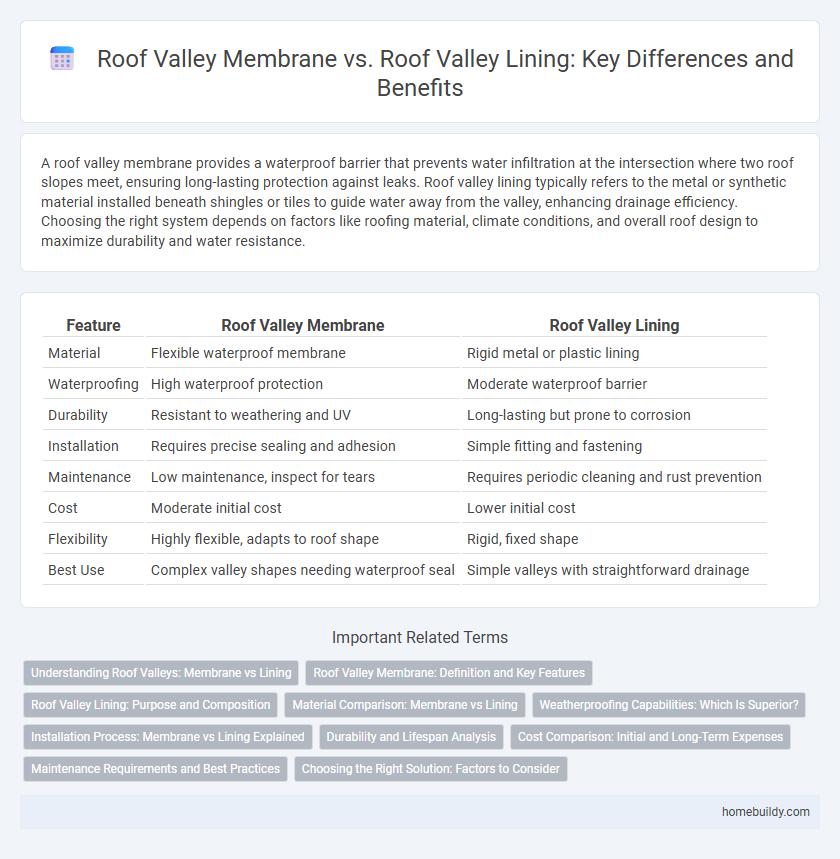A roof valley membrane provides a waterproof barrier that prevents water infiltration at the intersection where two roof slopes meet, ensuring long-lasting protection against leaks. Roof valley lining typically refers to the metal or synthetic material installed beneath shingles or tiles to guide water away from the valley, enhancing drainage efficiency. Choosing the right system depends on factors like roofing material, climate conditions, and overall roof design to maximize durability and water resistance.
Table of Comparison
| Feature | Roof Valley Membrane | Roof Valley Lining |
|---|---|---|
| Material | Flexible waterproof membrane | Rigid metal or plastic lining |
| Waterproofing | High waterproof protection | Moderate waterproof barrier |
| Durability | Resistant to weathering and UV | Long-lasting but prone to corrosion |
| Installation | Requires precise sealing and adhesion | Simple fitting and fastening |
| Maintenance | Low maintenance, inspect for tears | Requires periodic cleaning and rust prevention |
| Cost | Moderate initial cost | Lower initial cost |
| Flexibility | Highly flexible, adapts to roof shape | Rigid, fixed shape |
| Best Use | Complex valley shapes needing waterproof seal | Simple valleys with straightforward drainage |
Understanding Roof Valleys: Membrane vs Lining
Roof valley membranes offer superior waterproofing by creating a continuous barrier that prevents water infiltration, making them ideal for areas with heavy rainfall or snow. In contrast, roof valley linings, typically made of metal or flexible flashing materials, focus on directing water flow efficiently while providing moderate protection against leaks. Choosing between membrane and lining depends on factors such as climate, roof pitch, and maintenance requirements to ensure long-term roof durability.
Roof Valley Membrane: Definition and Key Features
Roof valley membrane is a waterproof material installed along roof valleys to prevent water infiltration and protect underlying structures. It is typically made of durable, flexible materials such as rubberized asphalt or synthetic polymers, ensuring long-lasting resistance to harsh weather conditions and UV exposure. Key features include superior water resistance, easy installation, and compatibility with various roofing materials, making it essential for effective roof valley protection.
Roof Valley Lining: Purpose and Composition
Roof valley lining serves as a critical waterproof barrier in roof valleys, preventing water infiltration and protecting underlying structures from damage. Composed typically of durable materials such as aluminum, lead, or synthetic membranes, it provides flexibility and resilience against thermal expansion and contraction. This lining enhances roof longevity by ensuring effective water drainage and reducing the risk of leaks in vulnerable valley areas.
Material Comparison: Membrane vs Lining
Roof valley membranes are typically made from durable, flexible materials like EPDM or bituminous compounds, offering superior waterproofing and resistance to temperature fluctuations. In contrast, roof valley linings often use galvanized steel or aluminum, providing robust mechanical protection but with increased risk of corrosion and less flexibility. Membranes excel in seamless coverage and adaptability, while linings provide structural reinforcement but may require regular maintenance due to metal fatigue and weather exposure.
Weatherproofing Capabilities: Which Is Superior?
Roof valley membranes provide superior weatherproofing capabilities compared to roof valley linings due to their seamless application and enhanced resistance to water infiltration. Membranes, often made from durable materials like EPDM or TPO, form a continuous barrier that effectively prevents leaks during heavy rain or snowmelt. Roof valley linings, typically composed of metal or asphalt-based materials, may develop gaps or corrosion over time, reducing their long-term weatherproofing reliability.
Installation Process: Membrane vs Lining Explained
Roof valley membrane installation involves carefully laying a continuous waterproof sheet that requires precise measuring and sealing to prevent water infiltration, ensuring long-lasting protection. Roof valley lining, on the other hand, is typically installed by pressing metal or plastic strips into the valley seams, offering a simpler, quicker application but less flexibility in dealing with roof movements. Both methods demand skilled labor but membrane systems provide superior durability in complex roofing geometries compared to traditional lining techniques.
Durability and Lifespan Analysis
Roof valley membranes typically offer superior durability compared to roof valley linings, as they are designed with advanced waterproofing materials that resist tearing, UV damage, and extreme weather conditions for up to 30 years. Roof valley linings, while easier to install, generally have a shorter lifespan of around 10 to 15 years due to their thinner composition and less robust material properties. Choosing a roof valley membrane ensures extended protection and reduced maintenance costs over time, making it a more cost-effective solution for long-term roof integrity.
Cost Comparison: Initial and Long-Term Expenses
Roof valley membranes typically have a higher initial cost due to advanced materials and installation techniques, whereas roof valley linings offer a more budget-friendly upfront option with simpler application. Over time, roof valley membranes provide greater durability and resistance to water infiltration, reducing maintenance expenses compared to roof valley linings, which may require more frequent repairs or replacement. Evaluating the total cost of ownership highlights membrane systems as a cost-effective investment for long-term roof valley protection.
Maintenance Requirements and Best Practices
Roof valley membranes require regular inspection to detect punctures, tears, or adhesion failures, with cleaning scheduled at least biannually to prevent debris buildup that can cause water pooling and leaks. Roof valley linings demand less frequent maintenance but need thorough checks for corrosion or seam integrity, especially in metal-based linings, with preventive coatings applied every few years to extend lifespan. Best practices involve ensuring proper installation of both systems, timely debris removal, and rapid repair of any damage to maintain effective water runoff and avoid structural deterioration.
Choosing the Right Solution: Factors to Consider
Roof valley membrane offers superior waterproofing with flexible, durable materials designed to withstand heavy rainfall and thermal expansion, ideal for long-term protection. Roof valley lining provides a cost-effective solution with metal or plastic liners that facilitate water flow but may require more frequent maintenance. When choosing between membrane and lining, consider factors such as climate severity, roof pitch, budget constraints, and desired lifespan to ensure optimal roof valley performance.
Roof valley membrane vs Roof valley lining Infographic

 homebuildy.com
homebuildy.com